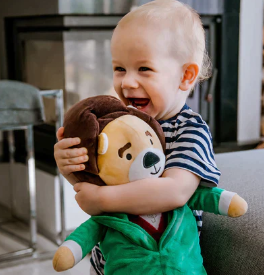Music is one of the best ways to create stronger connections with your child. This essential part of parenting lays the foundation for a healthy, supportive relationship that endures through the years.
Musical bonding transcends the simple act of listening or playing music; it’s a chance to engage with your child in an environment rich with rhythm, melody, and harmony. This approach to bonding offers a myriad of benefits to both you and your child and has the potential to turn every beat and tune into a step closer in your relationship.
Engaging with music opens up a world of cognitive, emotional, and social experiences for children. It encourages language development, enhancesemotional expression, and nurtures cognitive growth. For parents, it's a chance to step into their child's world, communicate in the universal language of music, and create a nurturing space filled with melodies and memories.
As we delve into various strategies for weaving music into your bonding moments, remember that each song you sing, each rhythm you share, and each dance step you take with your child builds bridges of love, trust, and mutual respect.
So, let's pick up the tempo and explore how the rhythm of music will enrich your family life, making every moment together a note worth cherishing.
Singing together
Singing with your child is a joyful and enriching activity that strengthens your emotional bond and supports their development. This shared experience offers comfort, joy, and security, as the rhythm and melody of songs provide a soothing backdrop for emotional expression and storytelling.
Did you knowsinging enhances language development, enriches vocabulary, and boosts pronunciation? The repetitive nature of songs aids in memory and cognitive skills while familiarizing children with the rhythm and patterns of language, building a solid foundation for their linguistic skills.
To make singing a fun and integral part of your routine, here are some helpful tips:
Choose a Variety of Songs:
Select a mix of fun, upbeat songs and soothing lullabies. Include songs with simple, repetitive lyrics for younger children and more complex tunes for older ones to challenge their memory and language skills.
Create singing rituals
Incorporate singing into your daily routines. Sing a playful song during bath time, a lullaby at bedtime, or a cheerful tune to start the day. These rituals will become cherished moments of connection.
Encourage interaction
Engage with the songs you sing. Use hand gestures, facial expressions, and dance moves to make the experience interactive and fun. This makes singing more enjoyable and supports your child's motor skills and social development.
Be expressive
Show enthusiasm and emotion when you sing. Your child will enjoy the performance and learn about expressing emotions in a healthy, fun way.
Involve your child
Encourage your child to choose songs, sing along, and even make up their own lyrics. This fosters creativity and gives them a sense of control and contribution.
Create a family playlist

Crafting a family playlist is much like weaving a musical tapestry that reflects your family's unique spirit, preferences, and journey. This shared playlist becomes more than a collection of songs; it evolves into a soundtrack of your collective experiences, emotions, and memories and plays a pivotal role in musical bonding and creating a sense of unity.
Creating and regularly updating a family playlist invites each member to contribute and ensures everyone's tastes and favorite tunes find a place in this musical mosaic. This inclusive activity celebrates individuality but also promotes respect and appreciation for each other’s preferences. It’s a way to foster a deeper understanding and connection within the family.
Here are some ways to curate a family playlist that resonates with everyone and strengthens your bond:
Start with a family music session
Gather everyone and discuss the types of music each family member enjoys. This initial session is a wonderful opportunity to explore different genres, artists, and songs together, discovering new music and revisiting cherished classics.
Select songs for different moods and occasions
Create a balanced playlist that includes upbeat tunes for family celebrations, soothing melodies for quiet evenings, and everything in between. A versatile playlist ensures you have the perfect soundtrack for any family moment.
Include songs with shared memories
Add songs that hold special meaning or evoke fond memories for the family, such as tunes from a memorable vacation, songs from favorite movies, or tracks that mark significant milestones. These songs become anchors of your shared history, evoking nostalgia and strengthening your bond every time they play.
Regularly update and revise
Make your family playlist a living, breathing entity by regularly updating it with new finds or seasonal tunes. Encourage family members to share new music they've discovered or request additions. This keeps the playlist fresh and ensures it continues to reflect the family’s evolving journey.
Creating a family playlist is a celebration of your family's unique journey, set to a soundtrack that is distinctly yours.
Explore musical instruments
When you and your child explore musical instruments together, you foster a symphony of shared experiences, understanding, and encouragement.
Learning an instrument is filled with moments of challenge, triumph, and joy. As you guide your child through the highs and lows of learning to play, you're there to celebrate each success and offer support through every struggle. This journey naturally builds trust and companionship as you engage in a meaningful, goal-oriented activity.
To introduce musical instruments in a way that resonates with your child's age and interests, consider the following ideas:
For younger children (toddlers and preschoolers)
For younger children, particularly toddlers and preschoolers, initiating their musical journey requires a thoughtful approach that balances fun with educational value.
Begin by introducing simple, durable instruments that not only withstand the enthusiastic play of young children but also encourage exploration and discovery. Hand drums, shakers, and xylophones are excellent choices for this age group.
These instruments are perfectly sized for little hands, making them accessible and inviting for young musicians. Beyond the joy of making noise, these instruments play a crucial role in developing motor skills, enhancing coordination, and introducing the fundamental concept of rhythm.
Transform the learning process into a playful experience. This is about instructing and engaging your child in a way that sparks their curiosity and creativity. Encourage them to experiment with the different sounds each instrument can produce. Whether it's the soft, mellow tones of a xylophone or the vibrant shake of a tambourine, every interaction is an opportunity for learning and growth.
Invite them to invent their own songs or try to mimic rhythms and melodies they hear in their favorite songs or stories. This process of exploration and creation is invaluable in nurturing their musical abilities and can significantly influence their appreciation for music as they grow.
Moreover, it's essential to celebrate their creative efforts enthusiastically. Their sounds might not always be melodious to adult ears, but each bang, shake, and tap is a step forward in their creative expression and cognitive development. You reinforce their confidence and encourage a positive association with music by showing excitement and praise for their musical explorations.
Incorporating music into your child's daily routine can also be beneficial. Background music during playtime, interactive music games, or even a family music night where everyone plays an instrument or sings together can further enrich their musical environment. These activities strengthen the bond between you and your child and immerse them in a world of sounds and rhythms, laying a solid foundation for a lifelong love of music.
By starting with the right instruments and fostering an environment of playful exploration, you set the stage for your child to develop musical skills and a deep love for artistic expression. This approach to early childhood music education promises to be rewarding and fun, paving the way for a future filled with musical adventures.
For school-aged children
Consider instruments that match your child's developmental level and interests. Recorders, ukuleles, and keyboards are great options that offer a gentle introduction to more structured music learning.
Engage in the learning process. Consider taking lessons together or learning alongside your child. Your involvement shows your child that you're in this together, creating a shared journey of growth and learning.
For older children and teenagers
Support their choices. Older children might be interested in more complex instruments like guitars, violins, or digital music production. Encourage their passion and provide the necessary resources to pursue their musical interests.
Collaborate on musical projects. Whether practicing together, composing a piece, or even performing as a family band, collaborate on music-related activities that align with their skills and interests.
Remember, exploring musical instruments with your child is not to master an instrument but to nurture a love for music, develop new skills, and, most importantly, create stronger connections with your child.
Attend live music events

The energy of a live performance, the shared excitement of the audience, and the beauty of music in its most vibrant form have a profound impact on both you and your child. These experiences provide a deeper appreciation for music and a shared sense of wonder.
Live music is an opportunity to immerse yourselves in acultural experience, to feel the music with every sense, and to create special moments that you'll both remember. Live music events also broaden your child's horizons, exposing them to different musical styles and cultures and inspiring curiosity and a love for the arts.
To ensure a harmonious and enjoyable first concert or musical outing with your child, try incorporating some of these things:
Choose the right event
Select a concert or musical performance suitable for your child’s age and interests. Many artists and venues offer family-friendly performances that cater to younger audiences and provide a welcoming and engaging experience for children.
Set expectations
Discuss the event with your child beforehand. Talk about the venue, the type of music they'll hear, and what to expect in terms of the audience, the sound level, and the duration of the performance. This preparation helps alleviate any apprehensions and build excitement for the event.
Plan accordingly
Make sure you arrive early to find good seats and to settle in comfortably. Bring any necessary items like snacks, water, or small cushions to make the experience more comfortable for your child. Consider bringing ear protection if the music is loud, especially for younger children.
Connect post-event
After the concert, talk about the experience with your child. Discuss what you both enjoyed, what you learned, and how the music made you feel. This reflection can deepen the emotional impact of the experience and strengthen your bond.
Step away from the everyday routine and immerse yourselves in the world of music to experience firsthand the power of live performance to unite, inspire, and create harmony.
Incorporate music into daily routines
Integrating music into the daily routines of your family life transforms ordinary moments into extraordinary ones. It strengthens bonds and creates a rhythm of joy, comfort, and togetherness. Music's versatility makes it a perfect companion for various daily activities, turning routines into rituals and chores into cheerful experiences.
Making music a natural and consistent part of your family's life doesn't require grand gestures; it's the small, deliberate acts that weave melodies into the fabric of everyday living.
Here are some practical ideas to infuse music into your daily routines, harmonizing your family life one note at a time:
Morning melodies
Start the day on a high note with an uplifting morning playlist. Let the music play as you and your family get ready. It’s a great way to infuse energy and positivity into the start of your day.
Musical mealtime
Use mealtime as an opportunity to introduce different genres of music. Play classical music during dinner to create a calming atmosphere or jazz during brunch for a lively vibe. Discuss the music, share your thoughts, and let this shared listening experience spark conversations.
Bedtime lullabies
End the day peacefully with a soothing bedtime lullaby. Create a playlist of gentle, calming music to help your child wind down and prepare for sleep. This musical end to the day is a comforting routine that your child looks forward to every night.
Educational music time
Incorporate music into learning and homework time. Play instrumental or classical music softly in the background to improve concentration and make learning sessions more enjoyable.
Transport tunes
Turn travel time into a musical adventure. Whether you're driving to school or taking a family trip, let music be your travel companion. Sing along, have mini dance parties at red lights, or play a game of guess-the-song to make the journey more fun and memorable.
Musical reflections
Encourage each family member to share a song that reflects their day or mood during family gatherings. This practice allows for musical expression and opens up heartfelt conversations to help everyone understand each other better.
Integrating music into your daily routines creates a powerful backdrop to your family life. It's a way to ensure that every day, no matter how ordinary, is touched by the magic of music.

Virtuoso Bears — Harmonizing family time with musical warmth
Weaving music into the fabric of family life has the extraordinary ability to transform our interactions and create stronger connections with your child. To further enhance this musical journey within your family, introduce the joy and elegance ofVirtuoso Bears into your home.
Virtuoso Bears are carefully crafted musical companions designed to bring the timeless beauty of classical music into your family’s daily life. Each bear is a maestro, holding a repertoire of 40 minutes of carefully selected classical pieces that add a touch of serenity, joy, and sophistication to your family’s routine. Pick your favorite composer orbundle all three for more savings!
Whether it’s during a cozy family evening, a playful afternoon, or a peaceful bedtime routine, these bears bring the soothing presence of classical music to your child’s side.
Embrace the harmonious blend of music, comfort, and family bonding with Virtuoso Bears, and let them play a part in your family’s journey of creating shared moments, nurturing connections, and making every day a little more melodious.
